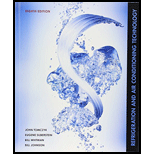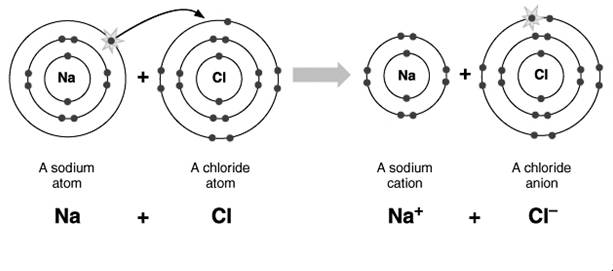
Concept explainers
The __________is that part of an atom that moves from one atom to another.
A. electron
B. proton
C. neutron
The part of an atom that moves from one atom to another.
Answer to Problem 1RQ
The correct answer is (a) electron.
Explanation of Solution
An atom is the smallest part of a substance that is made up of electron, neutron and protons. The neutrons as the name suggest has no charge, while the protons are positively charged ions and the electrons are negatively chargedions present in the outermost shell moves around the nucleus of an atom. When a sufficient amount of energy or force is applied to an atom, the outer electron become free and can move from one atom to another.
In the given figure, an atom of sodium having excess of electron and another atom of chlorine having a deficiency of electron thus, both the atoms become stable by transferring an electron from sodium atom to chlorine and forming a covalent bond between them.
Thus, the electron is the smallest ion that moves from one atom to another.

Proton:
The proton being heavier in mass as compared to electron cannot be able to move from one atom to another.
Neutron:
They are found in the nucleus of an atom.
The protons and neutrons stick together in the nucleus of an atom during normal conditions.
Want to see more full solutions like this?
Chapter 12 Solutions
Bundle: Refrigeration and Air Conditioning Technology, 8th + MindTap HVAC, 2 terms (12 months) Printed Access Card
- Solve this problem and show all of the workarrow_forwardSolve this problem and show all of the workarrow_forwarddraw the pneumatic circuit to operate a double-acting cylinder with: 1. Extension: Any of two manual conditions plus cylinder fully retracted, → Extension has both meter-in and meter-out, 2. Retraction: one manual conditions plus cylinder fully extended, → Retraction is very fast using quick exhaust valve.arrow_forward
- Correct answer is written below. Detailed and complete solution with fbd only. I will upvote, thank you. Expert solution plsarrow_forwardCorrect answer is written below. Detailed and complete solution with fbd only. I will upvote, thank you.arrow_forwardCorrect answer is written below. Detailed and complete solution with fbd only. I will upvote, thank you.arrow_forward
- Correct answer is written below. Detailed and complete solution only with fbd. I will upvote, thank you.arrow_forwardCorrect answer is written below. Detailed and complete solution only. I will upvote, thank you.arrow_forwardCorrect answer is written below. Detailed and complete solution with fbd only. I will upvote, thank you.arrow_forward
- Correct answer is written below. Detailed and complete solution only. I will upvote, thank you.arrow_forwardCorrect answer is written below. Detailed and complete solution with fbd only. I will upvote, thank you.arrow_forwardCorrect answer is written below. Detailed and complete solution only. I will upvote, thank you.arrow_forward
 Refrigeration and Air Conditioning Technology (Mi...Mechanical EngineeringISBN:9781305578296Author:John Tomczyk, Eugene Silberstein, Bill Whitman, Bill JohnsonPublisher:Cengage Learning
Refrigeration and Air Conditioning Technology (Mi...Mechanical EngineeringISBN:9781305578296Author:John Tomczyk, Eugene Silberstein, Bill Whitman, Bill JohnsonPublisher:Cengage Learning Automotive Technology: A Systems Approach (MindTa...Mechanical EngineeringISBN:9781133612315Author:Jack Erjavec, Rob ThompsonPublisher:Cengage Learning
Automotive Technology: A Systems Approach (MindTa...Mechanical EngineeringISBN:9781133612315Author:Jack Erjavec, Rob ThompsonPublisher:Cengage Learning

